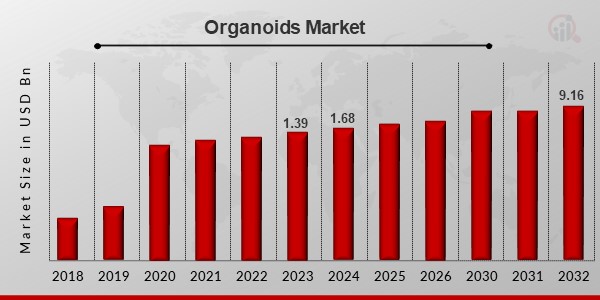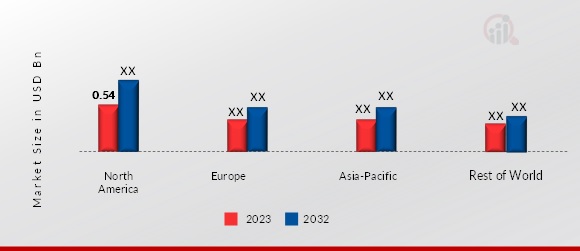Global Organoids Market Overview
The Organoids Market was valued at USD 1.39 billion in 2023. The industry is projected to grow from USD 1.68 billion in 2024 to USD 9.16 billion by 2032, exhibiting a compound annual growth rate (CAGR) of 23.55% during the forecast period (2024 - 2032). The rising demand for personalized medicine and growing application of drug discovery and toxicology studies are driving the market growth.

Source: Secondary Research, Primary Research, MRFR Database, and Analyst Review
Organoids Market Trends
- Rising demand for personalized medicine.
The rising demand for personalized medicine stands as a prominent driver propelling the growth of the Organoids Market. Personalized medicine, also known as precision medicine, revolves around tailoring medical treatment to the individual characteristics of each patient. This approach considers factors such as genetic makeup, environment, and lifestyle, aiming to provide more effective and targeted therapies. Organoids, miniature 3D tissue structures that mimic the functionality and complexity of organs, have emerged as a crucial tool in advancing personalized medicine.
One key aspect of personalized medicine is the recognition of the substantial variability in how individuals respond to treatments. Traditional approaches to drug development often rely on animal models or 2D cell cultures, which do not accurately represent human biology. Organoids offer a more physiologically relevant platform for studying disease mechanisms and testing drug responses. By using patient-derived organoids, researchers can better understand the unique characteristics of diseases and predict how individuals will respond to different treatments.
For instance, in cancer research, organoids derived from patient tumors allow scientists to assess the effectiveness of various anticancer drugs in a manner that closely mimics the patient's tumor microenvironment. This enables oncologists to identify the most suitable treatment options for individual patients, potentially improving treatment outcomes and reducing adverse effects. Additionally, organoids can be used to study the mechanisms of drug resistance, helping to develop strategies to overcome this challenge in cancer therapy.
Organoids Market Segment Insights
Global Organoids Product & Service insight
Based on product & service, the Organoids Market has been segmented into product and service. Among these segments, Product segment dominated the market in 2023. The product segment has the largest market share of 76.41%. Instruments and consumables are the major products. Instruments constitute a crucial component of the organoids market, encompassing a variety of sophisticated tools and equipment tailored for the generation, culture, and analysis of organoids. These instruments often include bioreactors, microfluidic devices, 3D cell culture systems, and advanced imaging platforms. Bioreactors, for instance, are essential for maintaining the physiological conditions necessary for the growth and development of organoids, mimicking the microenvironment found within living organisms. Microfluidic devices play a pivotal role in controlling the flow of nutrients and signaling molecules within organoid cultures, facilitating precise experimentation and analysis. Furthermore, 3D cell culture systems provide researchers with the means to culture and manipulate organoids in vitro, enabling the study of complex biological processes and disease mechanisms in a controlled laboratory setting. Advanced imaging platforms, such as confocal microscopy and high-content screening systems, offer researchers the ability to visualize and analyze organoid structures at high resolution, providing valuable insights into their morphological features and cellular dynamics. Overall, instruments play a crucial role in advancing organoid research by enabling scientists to create and study these miniature organ-like structures with unprecedented precision and fidelity.
The service segment of the organoids market includes a range of specialized services offered by contract research organizations (CROs), academic institutions, and biotechnology companies to support organoid-based research and drug discovery efforts. These services often include organoid generation and customization, disease modeling, drug screening, and preclinical testing, among others. Organoid generation services involve the generation of custom organoid models from patient-derived samples or engineered cell lines, tailored to specific research objectives or disease conditions. CROs and academic labs with expertise in organoid technology offer these services to researchers seeking to establish novel organoid models for their studies. Disease modeling services leverage organoid technology to recapitulate complex disease phenotypes in vitro, enabling researchers to study disease mechanisms and test potential therapeutic interventions in a physiologically relevant context. Drug screening services utilize organoid models to screen libraries of compounds or therapeutic agents for efficacy and toxicity, providing valuable insights into drug response and safety profiles prior to clinical trials. Preclinical testing services involve the evaluation of drug candidates using organoid-based models to assess their efficacy, pharmacokinetics, and safety profiles, helping to prioritize promising candidates for further development.
Figure 2: ORGANOIDS MARKET SIZE, BY PRODUCT & SERVICE, 2023 & 2032 (USD Billion)

Source: Secondary Research, Primary Research, MRFR Database, and Analyst Review
Global Organoids Type of Organoids Insights
Based on type of organoids, the Organoids Market has been segmented into Liver, Kidney, Pancreas, Intestine, Heart and Others. Among these segments, the Intestine segment dominated the market in 2023. The intestine Segment has the largest market share of 24.23%. Intestine organoids, also known as gut organoids or enteroids, are miniature versions of the intestine that recapitulate the crypt-villus architecture and cellular diversity of the intestinal epithelium. These organoids contain intestinal stem cells, enterocytes, goblet cells, enteroendocrine cells, and Paneth cells, among others. Intestine organoids are valuable models for studying intestinal development, investigating the pathogenesis of gastrointestinal diseases such as inflammatory bowel disease and colorectal cancer, and exploring host-microbiota interactions. They also serve as a platform for drug screening and personalized medicine approaches targeting intestinal disorders.
Kidney organoids are self-organizing structures which have an apparent resemblance to the nephron, the kidney's functional unit in charge of production and filtration of urine. These organoids are composed of several cell types that are present in the nephron, such as collecting duct cells, proximal tubule cells, distal tubule cells, and podocytes. Liver organoids are miniature versions of liver tissue that recapitulate the complex architecture and cellular composition of the human liver. These organoids contain hepatocytes, the primary functional cells of the liver, as well as other supportive cell types such as cholangiocytes and stellate cells. Pancreas organoids are complex structures that replicate the cellular makeup and architecture of the pancreas, including ductal cells, exocrine cells (such acinar cells), and endocrine cells (like insulin-producing beta cells). These organoids, which can be produced from tissue-specific progenitor cells or pluripotent stem cells, have been used to model pancreatic diseases like pancreatitis and diabetes as well as to screen for possible treatments that target pancreatic problems. The other segment of organoid models includes various tissues and organs, including the brain, lung, prostate, breast, and more. These organoids are utilized for studying tissue-specific biology, modeling diseases affecting these organs, and exploring therapeutic interventions.
Global Organoids Application Insights
Based on Application, the Organoids Market has been segmented into Drug Testing, Developmental biology, Personalized Medicine, Regenerative Medicine and Others. Organoids have emerged as a revolutionary tool in drug testing and development. Among these segments, Development Biology dominated the market in 2023. Development biology had the largest market share of 28.51%. These miniature organ-like structures mimic the behavior and functionality of real organs, allowing researchers to study the effects of drugs on specific tissues in a more accurate and ethically sound manner. Drug testing using organoids offers several advantages over traditional methods, including the ability to replicate complex physiological conditions and disease states more accurately. This segment of the market is witnessing significant growth as pharmaceutical companies increasingly recognize the potential of organoids to streamline the drug discovery process, reduce costs, and minimize reliance on animal models.
The study of organoids is essential to expanding the understanding of developmental biology. Researchers can examine the basic principles behind tissue formation and differentiation by simulating the organogenesis process in vitro. Aspects of organ formation such as tissue patterning, morphogenesis, and cell fate determination are all included in developmental biology. Personalized medicine aims to tailor medical treatment to individual patients based on their unique genetic makeup, lifestyle, and environmental factors. Organoids hold immense potential in this field by serving as patient-specific models for disease modeling and drug screening. The goal of regenerative medicine is to enhance patient health and quality of life by either replacing or repairing damaged tissues and organs. The others category includes areas such as disease modeling, toxicology screening, and basic research in fields outside of drug testing, developmental biology, personalized medicine, and regenerative medicine.
Global Organoids End-Users Insights
Based on End-Users, the Organoids Market has been segmented into Academic and Research Institutions, Pharmaceutical and Biotechnology Companies, Contract Research Organizations (CROs) and others. Academic and research institutions form a substantial portion of the end-users in the organoids market. These institutions are at the forefront of basic and translational research, constantly exploring new avenues in biomedical sciences. Pharmaceutical and Biotechnology Companies segment dominated the market in 2023. It had the largest market share of 46.05%.
Organoids are a significant market for pharmaceutical and biotechnology businesses, who use the technology for medication research and discovery. Compared to conventional cell culture systems, organoids provide a more physiologically appropriate model that helps researchers predict therapeutic efficacy, toxicity, and side effects more accurately early in the drug development process. Contract research organizations (CROs) play a crucial role in supporting organoids research and development activities. These organizations offer specialized services to academic institutions and pharmaceutical companies, ranging from assay development and screening to preclinical testing and regulatory support. Government research institutes, nonprofits, and clinical laboratories are included in the end-users segmentation of the organoids under the others category. Government research institutes provide academic institutions and biotechnology enterprises with infrastructure and fund research projects related to organoids.
Global Organoids Regional Insights
Based on region, the Organoids Market has been segmented into North America, Europe, Asia-Pacific, and the Rest of the World. North America accounted for the largest market share in 2023 and is anticipated to reach USD 3.42 billion by 2032, registering a CAGR of 22.88% during the forecast period.
The increase in the utilization of organoid-based research models in the biotechnology sector in the U.S. and Canada can be attributed to the advancements in technology that have enabled the development of 3D organoids and spheroids. In the U.S., major academic research institutions and biotechnology companies have been at the forefront of advancing organoid technology. Institutions like the Harvard Stem Cell Institute and the University of California, San Francisco, have made significant contributions to the field, developing novel methods for culturing organoids from various tissue types. Similarly, Canada has seen a rise in organoid research, with institutions like the University of Toronto and McGill University leading the way. Collaborative initiatives such as the Canadian Organoid Initiative (COI) have been established to facilitate knowledge sharing and resource allocation in the organoid research community.
The Americas region is followed by Europe, which accounted for the second largest organoids market share. One key driver is Europe's robust research infrastructure and substantial investment in life sciences. Countries like Germany, the United Kingdom, and the Netherlands are home to renowned research institutions and biotechnology companies leading organoid research. Initiatives such as the Human Cell Atlas project in the UK and the BioRegioN network in Germany are catalyzing innovation in organoid technology by providing funding and collaborative opportunities.
The Asia Pacific region is witnessing significant growth in the organoids market, driven by several key factors. Organoids, three-dimensional miniature organs derived from stem cells or tissue, hold immense potential in disease modeling, drug discovery, and regenerative medicine applications. In Asia Pacific, countries like Japan, China, and South Korea are at the forefront of organoid research and application due to their robust biotechnology and healthcare sectors, as well as strong government support for research and development.
Figure 3: ORGANOIDS MARKET BY REGION 2023 & 2032 (USD Billion)

Global Organoids Key Market Players & Competitive Insights
The Organoids Market is characterized by the presence of many global, regional, and local vendors. The market is highly competitive, with all the players competing to gain maximum market share. Intense competition, frequent changes in government policies, and regulations are key factors that impact market growth. The vendors compete based on cost, product quality, reliability, and aftermarket services. The vendors must provide cost-efficient and high-quality organoids to sustain their presence in an intensely competitive market environment.
Mergers and collaborations were also observed to expand the company's product portfolio. The growth of prominent industry players is dependent on various factors, such as market conditions, government support, and industry development. It is also projected that a rise in the investments for R&D will also boost the market's growth in the upcoming future.
Major players in the Organoids Market, including Thermo Fisher Scientific Inc, Inc, Merck KGgA, Corning Incorporated, STEMCELL Technologies, Bio-Techne, Molecular Devices, LLC, and others are making investments in R&D activities to boost market demand.
Molecular Devices, LLC is committed to promoting drug development and life science research. It is a top supplier of high-performance bioanalytical measurement instruments. Since its founding in 1983, the company has earned a solid reputation for providing cutting-edge solutions that enable researchers to expedite the rate of scientific discovery and help scientists understand the complexity of biology. Serving a broad spectrum of clients including academic institutions, pharmaceutical companies, biotechnology firms, and research laboratories globally, Molecular Devices boasts a varied portfolio that includes imaging systems, microplate readers, cellular analysis instruments, and automated electrophysiology platforms.
Moreover, In July 2023, Molecular Devices launched custom organoid line expansion service using unique bioprocess technology for high-throughput applications.
Key Companies in the Organoids Market include.
- Hub Organoids (Netherlands)
- NeyroblastGX (US)
- StemCell Technologies (Canada)
- Bio-Techne (US)
- Thermo Fisher Scientific Inc. (US)
- 3Dnamics Inc. (US)
- Molecular Devices, LLC (US)
- Merck KGaA (Germany)
- Corning Inc. (US)
- CN Bio Innovations Ltd. (UK)
Global Organoids Industry Developments
July 2023: Molecular Devices has launched custom organoid line expansion service using unique bioprocess technology for high-throughput applications.
August 2021: STEMCELL Technologies and Hubrecht Organoid Technology (HUB) have announced that they have signed an agreement for the use of tissue-derived organoids—including lung, intestinal, and liver organoids—for use in preclinical toxicology screening and non-cancer drug development services to be offered by the Contract Assay Services division of STEMCELL.
March 2021: Bio-Techne has released its new Cultrex UltiMatrix Reduced Growth Factor Basement Membrane Extract (RGF BME) to support organoid and pluripotent stem cell cultures.
Organoids Market Segmentation
Organoids Product & Service Outlook
Organoids Type of Organoids Outlook
- Liver
- Kidney
- Pancreas
- Intestine
- Heart
- Others
Organoids Application Outlook
- Drug Testing
- Developmental Biology
- Personalized Medicine
- Regenerative Medicine
- Others
Organoids End-users Outlook
- Academic and Research Institutions
- Pharmaceuticals and Biotechnology Companies
- Contract Research Organizations (CROs)
- Others
Organoids Regional Outlook
North America
Europe
- Germany
- France
- UK
- Italy
- Spain
- Rest of Europe
Asia-Pacific
- China
- Japan
- India
- South Korea
- Australia
- Rest of Asia-Pacific
Rest of the World
-
Middle East & Africa
-
South America
|
Report Attribute/Metric
|
Details
|
|
Market Size 2023
|
USD 1.39 billion
|
|
Market Size 2024
|
USD 1.68 billion
|
|
Market Size 2032
|
USD 9.16 billion
|
|
Compound Annual Growth Rate (CAGR)
|
23.55% (2024-2032)
|
|
Base Year
|
2023
|
|
Forecast Period
|
2024-2032
|
|
Historical Data
|
2019 to 2022
|
|
Forecast Units
|
Value (USD Billion)
|
|
Report Coverage
|
Revenue Forecast, Market Competitive Landscape, Growth Factors, and Trends.
|
|
Segments Covered
|
Product & Service, Type of Organoids, Application, End-user, and Region
|
|
Key Companies Profiled
|
Hub Organoids (Netherlands), NeyroblastGX (US), StemCell Technologies (Canada), Bio-Techne (US), Thermo Fisher Scientific Inc. (US), 3Dnamics Inc. (US), Molecular Devices, LLC (US), Merck KGaA (Germany), Corning Inc. (US), CN Bio Innovations Ltd. (UK)
|
|
Key Market Opportunities
|
Technical advancements enhancing organoids production and applications. |
|
Key Market Dynamics
|
Rising demand for personalized medicine. Growing aaplication of drug discovery and toxicology studies. |
Frequently Asked Questions (FAQ) :
The Organoids Market is anticipated to reach 9.16 billion at a CAGR of 23.55% during the forecast period of 2024-2032.
The Organoids Market is expected to grow at a 23.55% CAGR during the forecast period from 2024 to 2032.
The North America region market is estimated to hold the largest market share in the Organoids Market.
The key players include Hub Organoids (Netherlands), NeyroblastGX (US), StemCell Technologies (Canada), Bio-Techne (US), Thermo Fisher Scientific Inc. (US), 3Dnamics Inc. (US), Molecular Devices, LLC (US), Merck KGaA (Germany), Corning Inc. (US), CN Bio Innovations Ltd. (UK)
Developmental Biology segment dominated the market in 2023.





























